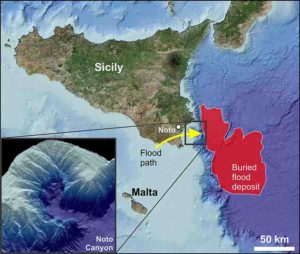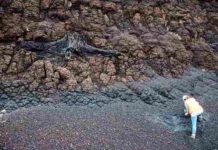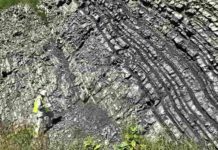
A study conducted by an international team of scientists has found new evidence supporting the hypothesis of a mega-flood occurring during the Zanclean period, in which water from the Atlantic poured back into the Mediterranean sea and ended the Messinian Salinity Crisis (MSC) 5 million years ago. The study, led by Professor Aaron Micallef from the University of Malta, has been published in the Scientific Reports journal.
Using seismic profiles and borehole data from offshore eastern Sicily, researchers have identified a large body of sediments buried in the subsurface of Sicily Channel which are characterized as being “extensive” and “chaotic.” They have named this mass of material Unit 2.
The study says that this huge mass of sediments is composed of materials eroded and transported by the great flow of water that flooded the Ionian Basin through the Strait of Sicily once the western basin of the Mediterranean was refilled with the contribution of water coming from the Atlantic Ocean that had poured in previously through the Strait of Gibraltar. This event is known as Zanclean megaflood.
The discovered sediments have been located over a layer of salts originated previously during the partial desiccation of the Mediterranean Sea during the MSC and under another layer of common marine sediments that were deposited after the flood and during the restoration of the normal marine conditions.
“The deposits identified in our study have little reflectivity of the seismic waves, they are seismically transparent, and present a disordered internal structure of the layers which is very similar to the sediments typically originated in catastrophic floods,” explains Daniel García-Castellanos, co-author of the study and researcher from Barcelona’s Institute of Earth Sciences Jaume Almera of the CSIC (ICTJA-CSIC).
The study indicates that the sedimentary body found next to the base of the Malta Escarpment, between the eastern and western Mediterranean Sea, is wedge-shaped, and its estimated thickness is up to 860 meters in some parts. According to the researchers, it would be the largest known megaflood deposit on Earth.
“According to the models of the paper that we published in Nature in 2009, the flood would have lasted only a few years, reaching discharges of up to 100 million cubic meters per second, about a rate thousand times the current flow of the Amazon River,” adds García-Castellanos.
Researchers have also identified a spot in the channel of Sicily as the most likely gateway for the eastern Mediterranean Zanclean flood across the Malta escarpment, the submarine canyon of Noto (southeast Sicily). The authors of the study explain that this canyon has a unique morphology—its amphitheatre-shaped head is 6 km wide and is “similar to that of bedrock canyons rapidly eroded by megafloods. “The researchers interpret the Noto submarine canyon as the collector of the cascading flow into the Ionian Basin.
The study points to the abrupt and catastrophic nature of the environmental changes that occurred during the Messinian period, the most important since the dinosaurs’ extinction 65 million years ago,” says Daniel García-Castellanos.
The Messinian Salinity Crisis: an unrecognizable Mediterranean Sea
About 6 million years ago, the connection between the Atlantic Ocean and the Mediterranean Sea was interrupted. This event led to the partial desiccation of the Mediterranean Sea, which became a giant saline lake, with an estimated sea-level drawdown of 1300-2400 meters. This event is known as Messinian Salinity Crisis (MSC).
A major open question about this period is how normal marine conditions were restored. The hypothesis of the Zanclean megaflood proposes that there was a massive inflow of water through the Strait of Gibraltar that first flooded the western Mediterranean Basin. Then, through the Strait of Sicily, which was once the division between the eastern and western basins, flooded the Ionian Basin. Some studies indicate that this filling process lasted between a few months and two years.
Reference:
Micallef, A., et al. (2018), Evidence of the Zanclean megaflood in the eastern Mediterranean Basin, Scientific Reports, 8(1), 1078, DOI: 10.1038/s41598-018-19446-3
Note: The above post is reprinted from materials provided by Institue of Earth Sciences Jaume Almera.










